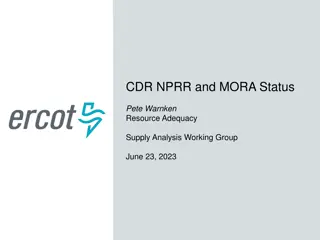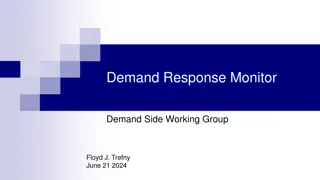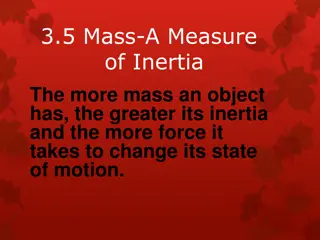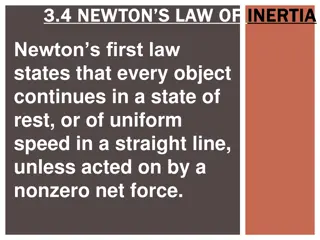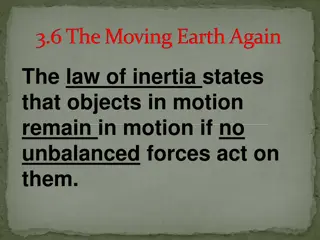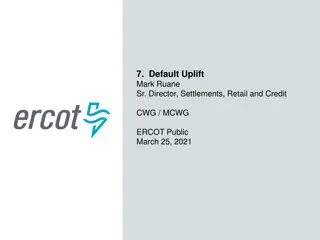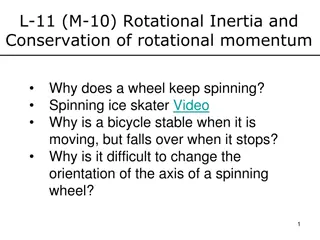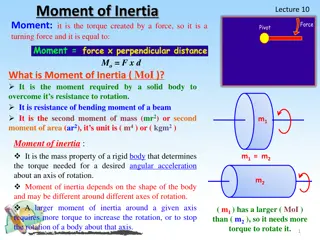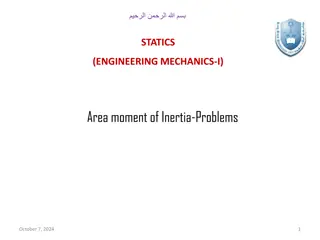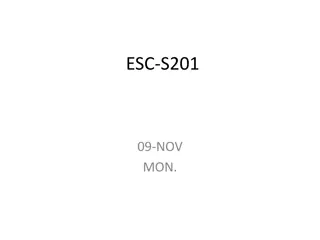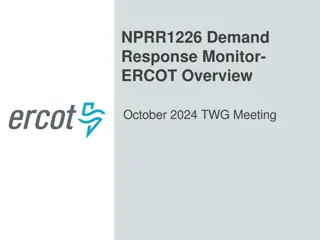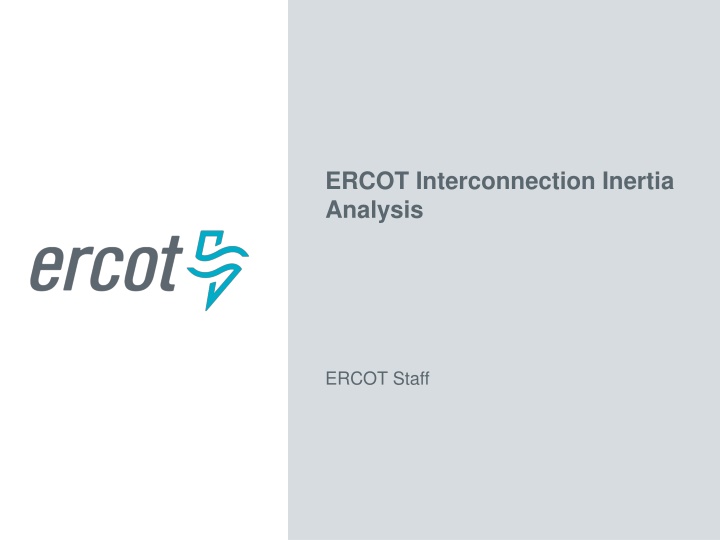
ERCOT Inertia Analysis & Monitoring
In this study, ERCOT analyzes the impact of integrating inverter-based generation on the system's inertia, implementing real-time monitoring and taking necessary actions as inertia levels approach critical thresholds. Explore the evolution of ERCOT's inertia management from 2013 to 2021, including calculations, monitoring, and response strategies.
Download Presentation

Please find below an Image/Link to download the presentation.
The content on the website is provided AS IS for your information and personal use only. It may not be sold, licensed, or shared on other websites without obtaining consent from the author. If you encounter any issues during the download, it is possible that the publisher has removed the file from their server.
You are allowed to download the files provided on this website for personal or commercial use, subject to the condition that they are used lawfully. All files are the property of their respective owners.
The content on the website is provided AS IS for your information and personal use only. It may not be sold, licensed, or shared on other websites without obtaining consent from the author.
E N D
Presentation Transcript
ERCOT Interconnection Inertia Analysis ERCOT Staff
Effect of Synchronous Inertia on System Frequency With increasing integration of inverter-based generation, there could be periods when total inertia of the system could be low since less synchronous machines will be online. UFLS trigger 2 PUBLIC
Inertia Calculation In 2013, as instantaneous wind power penetration reached 30%, ERCOT started analyzing impacts of inverter-based generation on system inertia. In 2015, ERCOT implemented a real-time inertia calculation using inertia parameters of each individual synchronous generator and its status (on/off) telemetry. ????= ?? ???? ? ? where I is the set of online synchronous generators or condensers, MVAiis MVA base of on-line synchronous generator or synchronous condenser i, and Hiis inertia constant for on-line generator or synchronous condenser i in a system (in seconds on machine MVAi) 3 PUBLIC
Inertia Monitoring in Real-Time In 2016, inertia monitoring was implemented in the control room. Visual alarms are raised alarms when inertia gets close to critical levels. As inertia approaches critical levels, ERCOT System Operators may take actions to bring additional synchronous generation resources with sufficient inertia online. Current system inertia posted on ERCOT.com https://www.ercot.com/content/cdr/html/real_time_system_conditions.html 4 PUBLIC
ERCOT Inertia 2013-2021 2013 3/10 3:00 AM 2014 3/30 3:00 AM 2015 11/25 2:00 AM 2016 4/10 2:00 AM 2017 10/27 4:00 AM 2018 11/03 3:30 AM 2019 3/27 1:00 AM 2020 05/01 2:00 AM 2021-EMS 03/22 1:00 AM Date and Time Min synch. Inertia (GW*s) System load at minimum synch. Inertia (MW) Non-synch. Gen. in % of System Load * Using updated inertia constants, re-calculated 2021 min = 116.6 GW*s 132 135 152 143 130 128.8 134.5 131.1 109.6* 27,831 28,425 28,397 24,726 24,540 27,190 29,883 30,679 31,767 47 54 53 31 34 42 50 57 66 5 PUBLIC
Inertia by Unit Type during Minimum Inertia Hour 2013 3/10 3:00 AM 2014 3/30 3:00 AM 2015 11/25 2:00 AM 2016 4/10 2:00 AM 2017 10/27 4:00 AM 2018 11/03 3:30 AM 2019 3/27 1:00 AM 2020 05/01 2:00 AM 2021-EMS 03/22 1:00 AM * Using updated inertia constants, re- calculated 2021 min = 116.6 GW*s Date and Time Min synch. Inertia (GW*s) 132 135 152 143 130 128.8 134.5 131.1 109.6* 6 PUBLIC
Inertia by Unit Type during Minimum Inertia Hour 2021 7 PUBLIC
Low Inertia Hours 2017-2021 8 PUBLIC
Wind Generation Capacity +3,296 MW +1,261 MW +2,083 MW +1,079 MW +3,035 +1,805 MW +3,129 MW +1,629 MW 9 PUBLIC
Wind Curtailments Curtailment % is calculated based on potential uncurtailed annual energy yield 10 PUBLIC
High Wind Generation Hours 2017-2021 11 PUBLIC
Solar Generation Capacity +4,300 MW +1,692 MW +425 MW 12 PUBLIC
Solar Curtailments 13 PUBLIC
Low Net Load Hours 2017-2021 14 PUBLIC
Low Load Hours 2017-2021 15 PUBLIC
Coal vs Combined Cycle Interplay Combined Cycle Plant has about 1.5x higher inertia than a Coal Plant with the same MVA rating 16 PUBLIC
Generation Retirement 22 MW of GAS capacity and 213 MW of Wind capacity retired in 2021. 17 PUBLIC
PUN Inertia 18 PUBLIC
Summary All other factors being constant, inertia would decline in proportion to installed capacity of inverter-based generation; Inertia is dependent on the resources that are online at any given time. Resource commitment is a function of load, inverter-based generation and available thermal resources. ERCOT load is growing, which affects unit commitment and inertia trend; Increases commitment of Combined Cycle (CC) generation result in higher overall inertia. If retired Coal generation is replaced by CCs in unit commitment, then inertia increases as well. Levels of wind output during low load periods affects inertia Private Use Network generation provides a significant portion of system inertia and currently does not respond to energy price variations like other Resources In 2021, a variety of factors may have affected thermal unit availability; there was an overall decline in inertia from CCs and relatively lower inertia compared to past years 19 PUBLIC
Thank you! Questions? jackson.dubro@ercot.com pengwei.du@ercot.com PUBLIC
Appendix 21 PUBLIC
Natural Gas Prices https://www.macrotrends.net/2478/natural-gas-prices-historical-chart 22 PUBLIC
Relative Wind Production 2013-2021 Actual hourly wind power production is normalized by installed capacity at the time and ordered from lowest to highest level for each year to compare how productive each year was. 23 PUBLIC
Relative Solar Production 2013-2021 Actual hourly solar power production is normalized by installed capacity at the time and ordered from lowest to highest level for each year to compare how productive each year was. 24 PUBLIC
Coal vs Combined Cycle Interplay Combined Cycle Plant has about 1.5 time higher inertia than a Coal Plant with the same MVA rating 25 PUBLIC


